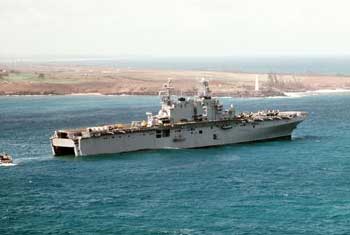USS
Belleau Wood LHA-3 Ship history:

Homeported in San Diego, California in October 1978, Belleau Wood
participated in her first full-scale operation in 1979 off the coast of
Hawaii. In early 1979 she reported to Long Beach Naval Shipyard in Long
Beach, California for a one-year engine overhaul. Belleau Wood began her
first major deployment in January 1981. The ship rescued 150 Vietnamese
refugees, earning the crew the Humanitarian Service Medal. The deployment
included three major exercises and eight port visits. Belleau Wood returned
to San Diego in August 1981. In August 1982, the ship began her second
deployment, and participated in four major amphibious exercises including
Jade Tiger 83. Her third successful deployment ran from January to July
1984.
The ship then completed an 11-month complex overhaul at Puget Sound
Naval Shipyard, Bremerton, Washington. In January 1987, Belleau Wood got
underway for her fourth deployment. The crew participated in four major
exercises, including the first winter amphibious exercises conducted in the
Aleutian Islands since World War II, and introduced the ship to the AV-8B
Harrier "jump jet".
The ship also received the Admiral Flatley Memorial
Award for Aviation Safety in 1987. In January 1989, Belleau Wood departed
for the Western Pacific. Over the next five months, the ship participated in
Exercise Team Spirit 89 in Korea and Exercise Valiant Usher in the
Philippines and Korea. On 4 October 1989, the ship hosted the Minister of
Defense of the Soviet Union during his historic visit to the United States.
Belleau Wood entered her second complex overhaul at the Long Beach Naval
Shipyard in 1990. Major work included an upgrade to CIWS and installation of
the Rolling Airframe Missile (RAM) System.
On 31 August 1992, Belleau Wood
sailed out of San Diego for the last time, bound for her new homeport in
Sasebo, Japan. During this transit, the ship provided disaster relief to the
people of Kauai, Hawaii after Hurricane Iniki ravaged the island. For this,
the crew was awarded its second Humanitarian Service Medal. Upon arrival in
Japan, Belleau Wood joined Amphibious Group 1 and Amphibious Squadron 11,
and became the world's only forward deployed large deck amphibious ship.
On
27 October 1992, Petty Officer Third Class Allen R. Schindler, Jr, who was
rumored among the crew to be homosexual, was brutally murdered in a park in
Sasebo by two shipmates, a case that emerged into the public eye months
later as newly-elected President Bill Clinton unveiled his "Don't Ask Don't
Tell" policy.
On 24 November 1992, Belleau Wood became the last ship to sail
out of the Philippines while conducting the final withdrawal of U.S. forces
from Subic Bay Naval Base and Naval Air Station Cubi Point. Following her
move to Japan, Belleau Wood became a familiar sight at joint military
exercises such as Valiant Usher in Australia, Team Spirit in Korea, Cobra
Gold in Thailand and Tandem Thrust near Guam (originally in Australia).
Belleau Wood also became the first large-deck Navy ship to undergo pierside
maintenance by COMLOGWESTPAC, Singapore.
Belleau Wood participated in the
World War II 50th anniversary commemoration ceremonies in Guam and the
Philippines and served off the coast of Somalia in 1995 as the command
platform for Operation United Shield. In July 2000, Belleau Wood took part
in the largest crew swap to date when she was relieved as forward deployed
amphibious assault ship. The procedure started when USS Essex (LHD-2)
arrived in Sasebo on 13 July 2000. The swap was part of a planned rotation
of forward deployed naval forces in Japan, and was the third crew-swap
exchange. The ships’ crews simply switched ships, minimizing the impact of
moving families from homeport to homeport. Sailors in Sasebo assigned to
Belleau Wood, moved on to Essex, while sailors from San Diego assigned to
Essex moved aboard Belleau Wood. Belleau Wood and the San Diego-based crew
then returned to San Diego in mid-August to begin overhaul and maintenance
cycles.
During 2002, Belleau Wood was the backdrop for the making of the
movie Antwone Fisher starring Derek Luke, Joy Bryant, and Denzel Washington.
In November 2003, Belleau Wood was the site of another first when Brigadier
General Joseph V. Medina took command of Expeditionary Strike Group Three,
of which Belleau Wood was the flagship. This event marked the first time in
history that a United States Marine Corps officer took command of a naval
flotilla.
The ship was decommissioned on 28 October 2005. She was sunk as
part of RIMPAC '06 exercises on 13 July 2006. Significance of the name USS
Belleau Wood mascot as displayed on the island superstructure.
USS
Belleau Wood LHA 3 US Navy Namesake History:
The ship was named in memory of the World War I Battle of Belleau Wood, in which
United States Marines of the Fourth Brigade, American Expeditionary Forces,
defeated the German troops after nearly four weeks of intense fighting. It
is said that the Germans referred to them as Teufel Hunden—Devil Dogs—and it
was this moniker that became the ship's mascot, and one of the nicknames for
US Marines (Devil Dog). The official seal of Belleau Wood is a blend
of symbols. An image of a fighting U.S. Marine, in World War I battle dress,
is at the center of the plaque. He carries a rifle with
bayonet, and seems to be
beckoning someone to follow him. Surrounding the figure are the gold cross,
shield and swords of the
Croix de guerre,
the French medal awarded
to the Marines who distinguished themselves at Belleau Wood. In that
tradition, Marines of the Fourth Brigade are permitted to wear the French
fourragère to this day. Twelve gold battle stars in a field of blue line the
top of the coat of arms. They stand for the World War II record of the first
USS Belleau Wood (CVL-24). The gap between the sixth and seventh stars
represents the ship's only break in her war record. On 30 October 1944,
while off Leyte Gulf, Belleau Wood was struck by a kamikaze. The light
aircraft carrier had to undergo repairs and an overhaul, hence the gap. Blue
and gold, prevailing hues of the coat of arms, are the traditional colors of
the United States Navy. The tricolor (red over white over blue) is a
reminder that the Battle of Belleau Wood occurred in France, and that
Marines who gave their lives at Belleau Wood did so in the defense of
another nation's freedom. The segments also bring to mind the colors of the
United States.